Struggling with Finances? 12 Proven Steps to Recover from a Setback and Rebuild Your Financial Health
Published: 27/03/2025
It’s a feeling many of us know all too well: sitting down to check your bank account, only to feel your heart sink. Maybe an unexpected expense came out of nowhere, or perhaps life just dealt you a hard blow, and now your finances are in disarray. The stress piles on—how will you get back on track? It’s frustrating, but here’s the thing: you can recover and rebuild.
Financial setbacks are tough.In fact, a Federal Reserve survey found that 60% of Americans have less than $500 in savings. But don’t worry—by taking the right steps, you can regain control and start rebuilding your financial health.”
In this post, I’ll walk you through 12 proven steps to help you get back on track. From managing debt to building an emergency fund, these actionable tips will help you move forward with confidence.
So, what would it feel like to finally have a clear plan to fix your finances? Keep reading to take the first step toward a healthier financial future.
Step 1: Assess Your Current Financial Situation
The first step in rebuilding your financial health is understanding exactly where you stand. You can’t improve what you don’t measure, so take the time to evaluate your finances with clarity. Here’s how:
- List Your Income: Write down all sources of income, including your salary, side gigs, or passive income.
- Calculate Your Debt: List all your debts—credit cards, student loans, car loans, etc.—and note their balances and interest rates.
- Track Your Expenses: Review your monthly expenses. Be sure to include essentials like rent, utilities, and groceries, as well as non-essentials like entertainment and dining out.
- Check Your Savings: Take a look at your savings accounts, emergency funds, or any investments you may have.
This simple template can help you get a clear picture of your financial situation. Once you have everything listed out, you’ll have a better idea of what needs immediate attention and where to focus your efforts.
Step 2: Create a Temporary Budget to Help You Stay Afloat
When money is tight, creating a temporary budget is essential to make sure you’re focusing on your needs, not wants. This budget will help you prioritize the essentials and cut back on things you can do without for the time being. Here’s how to get started:
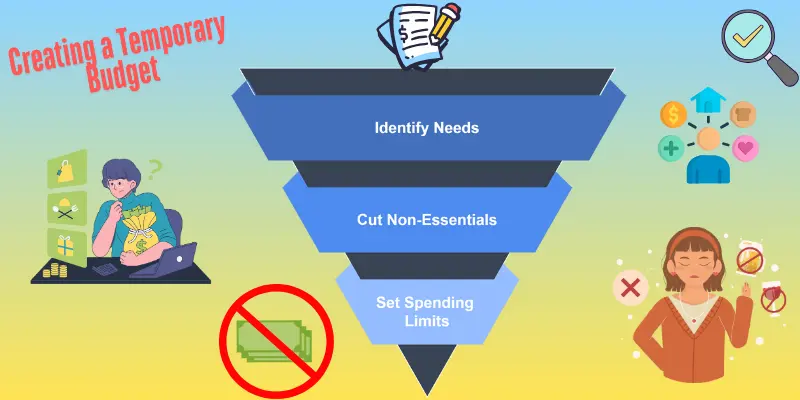
- Identify Your Needs: These are the must-haves that keep you going—like housing, utilities, food, transportation, and insurance.
- Cut Non-Essentials: Limit spending on things like entertainment, dining out, and impulse buys. Every penny saved can help you stay afloat while you work on getting back on track.
- Set a Realistic Spending Limit: Assign a spending limit for your needs and stick to it. This will help you stay disciplined and focused on your priorities.
- Essential Expenses (Housing, utilities, food, etc.): 75%
- Non-Essential Expenses (Dining out, entertainment, etc.): 25%
By cutting back on non-essentials, you can redirect money toward securing your basic needs and stabilizing your finances. This temporary budget gives you a clear, manageable plan for the short term while you focus on rebuilding.
Step 3: Build an Emergency Fund (If You Haven’t Already)
An emergency fund is one of the most important tools in protecting your financial health. If you don’t already have one, don’t worry—starting small can make all the difference. Here’s how to begin:
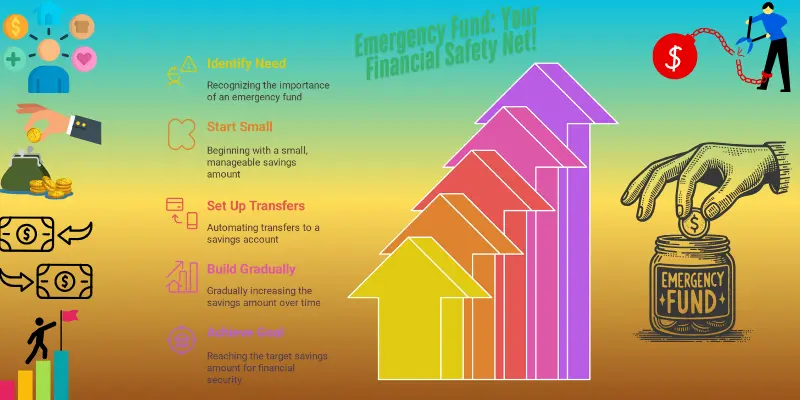
- Start Small, But Consistent: Begin by saving a small, manageable amount each week or month. Even $20 a week can add up over time.
- Set Up Automatic Transfers: Make saving easy by setting up an automatic transfer to a dedicated savings account for emergencies. This way, you won’t have to think about it, and the money will grow without you noticing.
- Build Gradually: While $1,000 is a great initial goal, you can aim for 3 to 6 months of expenses in the long term. Starting small keeps you motivated while you work toward this bigger goal.
Actionable Tip: Set up an automatic transfer from your checking account to your emergency savings account. Even if it’s just $50, it will add up over time and provide peace of mind.
Saving just $50 a week can add up to $1,000 in less than five months. By keeping your contributions consistent, you’ll be able to build an emergency fund that can protect you when unexpected expenses arise.
By starting small and staying consistent, you can create a safety net that helps you navigate life’s unpredictable moments.
Your emergency fund is your financial oxygen mask. You can’t help others or plan for the future if you’re gasping for cashSuze Orman, Personal Finance Expert
Step 4: Communicate with Creditors and Lenders
Facing a financial setback can make you want to avoid your creditors and lenders, but this is actually the time to reach out. Many creditors are willing to work with you if you’re proactive about your situation. Here’s what you can do:
- Don’t Avoid the Problem: Ignoring the issue only makes things worse. Instead, contact your creditors or lenders to discuss options like deferred payments, lower interest rates, or payment plans that work for you.
- Ask for Help: Many creditors offer hardship programs that could give you temporary relief. Don’t be afraid to ask for what you need—it could be exactly what helps you stay on track.
- Be Honest: Let them know your current situation and your intention to pay. Being upfront can often lead to more flexibility.
You don’t have to navigate this alone. There are also government programs and relief options available to assist individuals facing financial hardship. Check out these resources for potential support:
- The Consumer Financial Protection Bureau (CFPB)
- National Foundation for Credit Counseling (NFCC)
- Government Relief Programs for Debt Assistance
By communicating with your creditors early on, you can often find ways to ease the financial burden and stay on top of your obligations. Don’t hesitate to ask for help—you have options available.
Creditors would rather work with you than chase you. Honesty and proactive communication can turn a crisis into a manageable plan.Lynnette Khalfani-Cox, The Money Coach
Step 5: Increase Your Income Stream (If Possible)
When money is tight, finding ways to earn extra cash can make a big difference. Fortunately, there are plenty of side hustles and gigs that can help boost your income without a full-time commitment. Here’s how you can start:
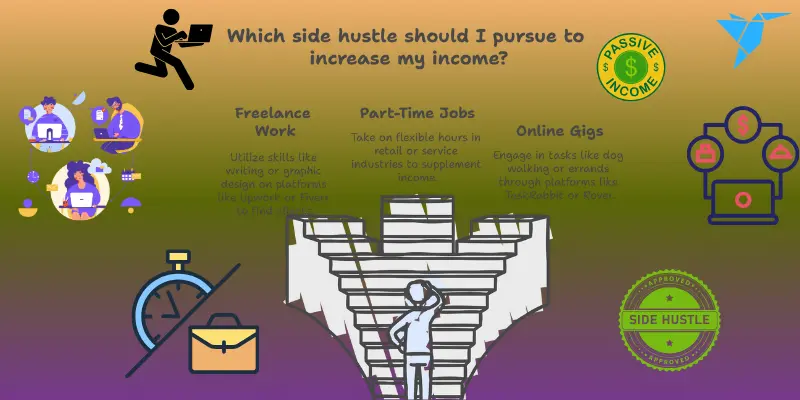
- Side Hustles and Gigs: Look for flexible ways to earn extra money, such as freelancing, part-time jobs, or online gigs. Whether it’s writing, graphic design, or delivering food, there’s something for everyone.
- Freelance Work: If you have a skill—writing, graphic design, coding, or marketing—there are platforms like Upwork and Fiverr that allow you to find clients easily.
- Part-Time Jobs: Many retail or service-based jobs offer flexible hours that you can take on in addition to your main job.
- Online Gigs: Websites like TaskRabbit and Rover allow you to find gigs like dog walking or running errands, which you can do during your free time.
Example: Beginner-Friendly Side Hustles You Can Do from Home
By increasing your income stream, you can not only ease the burden of financial setbacks but also have more flexibility to rebuild your savings and pay down debt. The best part? Many of these side hustles allow you to work from home and set your own schedule.
So, why not start today? Pick one side hustle and see how much extra cash you can make this month!
A side hustle isn’t just extra income—it’s a lifeline. It gives you options when your main income feels shaky.Chris Guillebeau, Author of Side Hustle
Step 6: Stay Consistent and Track Your Progress
Consistency is key to any financial recovery. To truly regain control over your finances, you need to regularly monitor and adjust your progress. Tracking your spending and savings ensures that you’re staying on track, catching any setbacks early, and making necessary adjustments along the way. Here’s how to stay consistent:
- Monitor Your Financial Recovery: Set aside time each week or month to review your budget, track your spending, and ensure you’re hitting your financial goals. This helps you stay motivated and make course corrections if needed.
- Use Tools to Track Your Progress: Budgeting apps or spreadsheets can make tracking easier and give you a clear picture of where your money is going. These tools can automatically categorize expenses, set reminders, and even offer suggestions for saving.
- Make Adjustments as Needed: If you find that your expenses are creeping up or you’re not meeting your savings goal, don’t be afraid to adjust your budget or spending habits. Regular check-ins help you stay on top of changes.
Actionable Tip: Set Up Monthly Check-Ins
Make it a habit to schedule a monthly financial review. This could be as simple as opening your budgeting app, reviewing your spending, and adjusting your budget based on your current situation. Staying consistent will help you remain on track and avoid slipping back into old habits.
Example: Free Budgeting Apps and Templates
Here are some tools to help you track your progress:
- Mint: A popular, free app that automatically tracks your spending and provides financial insights.
- YNAB (You Need a Budget): Great for budgeting and planning, with a focus on helping you give every dollar a job.
Tracking your progress regularly is one of the most important steps to financial recovery. With the right tools, you can stay on top of your goals and adjust when needed, making the process feel more manageable. Keep your eye on the prize, and don’t forget to celebrate small wins along the way!
Step 7: Rebuild Your Credit and Long-Term Financial Health
Rebuilding your credit and securing long-term financial health is crucial after experiencing a financial setback. While it takes time, the right steps can help you restore your credit score and set yourself up for future success. Here’s how to get started:
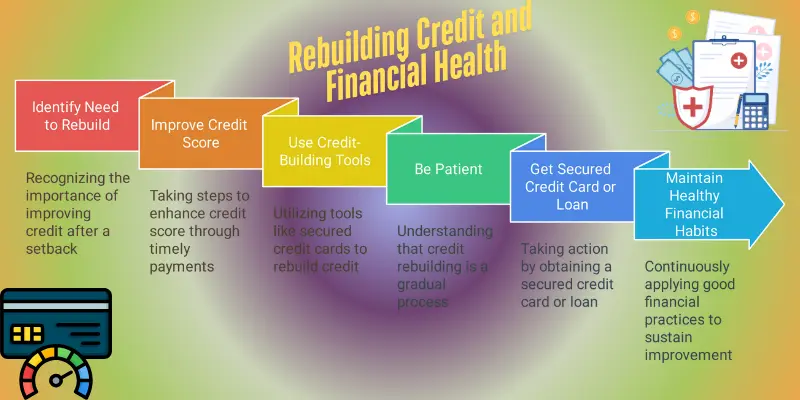
- Improve Your Credit Score: A good credit score opens the door to better loans, lower interest rates, and even job opportunities. Start by paying your bills on time—late payments have a major impact on your credit score. Reduce your credit card debt and avoid accumulating new debt to show creditors you’re responsible.
- Use Credit-Building Tools: There are several tools designed to help you rebuild credit, such as secured credit cards or credit-builder loans. These options give you the opportunity to make small, manageable payments that contribute to your credit score.
- Be Patient: Rebuilding your credit takes time, but consistent effort can make a significant difference. Start by focusing on paying off any high-interest debt first, and gradually increase your credit score as you maintain healthy financial habits.
Actionable Tip: Get a Secured Credit Card or Small Loan
A secured credit card or a credit-builder loan can help rebuild your credit score by allowing you to demonstrate responsible credit use. With a secured credit card, you’ll deposit money into a savings account that serves as collateral for the card, ensuring that you can rebuild your credit without risking debt. Make small purchases and pay the bill on time to show credit bureaus you’re able to manage debt responsibly.
Example: Credit-Building Timeline
Rebuilding your credit and strengthening your financial health may take time, but the efforts you put in today will pay off in the long run. Stay consistent, make timely payments, and avoid unnecessary debt. The road to a stronger credit score is within your reach!
Step 8: Cut Unnecessary Subscriptions and Memberships
One of the easiest ways to free up some cash and improve your financial situation is to cut out subscriptions and memberships that you no longer use or need. These small, recurring expenses can add up quickly without you even noticing. Here’s how to start trimming the fat:
Evaluate Your Value: Ask yourself if these services are worth the money. If you’re not using them regularly or getting your money’s worth, it might be time to cancel. Even if you don’t want to cancel outright, many services allow you to pause or temporarily suspend memberships.
Identify What’s No Longer Essential: Take a hard look at all your monthly subscriptions—streaming services, gym memberships, magazine subscriptions, and apps. Are you really using them? For example, do you need three different streaming services or a gym membership you haven’t used in months?
Actionable Tip: Cancel or Pause Unused Subscriptions
Here’s how to make it easier:
- Review your bank or credit card statements for recurring charges.
- List every subscription and membership you’re paying for, and check how often you actually use them.
- Cancel or pause subscriptions that you don’t use often or are not essential. Most streaming services, gyms, and apps allow you to easily cancel or pause your membership online.
Example: Popular Subscription Services and Average Costs
Cutting back on unnecessary subscriptions can make a big difference to your budget—especially when you’re looking to rebuild your finances. Don’t feel guilty about canceling what you don’t need—your financial health comes first. Review your subscriptions today, and save yourself some cash!
Step 9: Seek Financial Counseling or Debt Relief Programs
When you’re facing a financial setback, sometimes the best step is to reach out for help. If you’re feeling overwhelmed by debt or unsure how to manage your finances, getting professional advice can provide the clarity and support you need. Here’s why financial counseling or a debt relief program might be the solution you need:
- Get Professional Help: Speaking to a financial advisor or credit counselor can help you map out a realistic plan for paying off debt, improving your credit, and managing your finances moving forward. These experts can offer guidance tailored to your specific situation.
- Consider Debt Relief Programs: If you’re struggling with overwhelming debt, a debt relief program may be worth considering. Programs like debt management plans (DMPs) can consolidate your payments, reduce interest rates, and help you pay off your debt more efficiently.
Asking for help isn’t a sign of failure—it’s a strategic move. A financial counselor can see blind spots you might miss.Farnoosh Torabi, Host of So Money Podcast
Actionable Tip: Use Reputable Resources for Help
There are many trusted resources that can assist you in navigating your financial recovery:
- National Foundation for Credit Counseling (NFCC): The NFCC offers free or low-cost credit counseling and debt management services.
- Debt Management Plans (DMPs): A DMP allows you to make a single monthly payment to a credit counseling agency, which then pays your creditors on your behalf. This can simplify your payments and sometimes reduce your interest rates.
Example: Benefits of a Debt Management Plan
A Debt Management Plan can help you:
- Consolidate multiple payments into one easy monthly payment.
- Lower interest rates and waive late fees.
- Pay off debt more quickly, usually within 3-5 years.
Seeking professional help can feel like a big step, but it’s one that can save you time, stress, and money in the long run. If you’re feeling stuck, don’t hesitate to reach out for expert advice. With the right guidance, you can regain control of your finances and get back on track.
Step 10: Sell Unused Items for Extra Cash
One of the quickest ways to put a little extra cash in your pocket is by decluttering your home and selling items you no longer need. Not only will this give you a fresh start, but it can also provide a quick financial boost. Here’s how you can turn your unused items into extra income:
Declutter and Earn:
Look around your home—are there old electronics, clothes, furniture, or gadgets gathering dust? Many of these items could be sold online for cash. Platforms like eBay, Facebook Marketplace, and Poshmark make it easy to list and sell items locally or to a wider audience.
Actionable Tip: Sell Smarter, Not Harder
- Step 1: Identify items that are still in good condition (e.g., gently used clothing, old electronics, furniture, or books).
- Step 2: Take clear, high-quality photos of each item to make them stand out. Show the item from multiple angles and include any imperfections.
- Step 3: Write a simple, honest description, and set a reasonable price. For items in high demand (like phones, electronics, or designer clothing), you may want to research what similar items are selling for.
- Step 4: List your items on popular platforms (Facebook Marketplace, eBay, Poshmark, or OfferUp) to maximize your chances of selling.
Example: Common Items Sold for Extra Cash Here’s a quick list of items that people commonly sell for extra cash:
- Electronics: Old phones, tablets, laptops, gaming consoles, cameras.
- Clothing: Gently used clothing, shoes, handbags, and accessories (especially branded items).
- Furniture: Sofas, chairs, coffee tables, and bookshelves.
- Books and DVDs: Unused or unwanted books, DVDs, and video games.
- Appliances: Small kitchen appliances like blenders, toasters, or coffee makers.
Selling your unused items can be a great way to add some extra cash while also freeing up space in your home. Plus, it’s an environmentally friendly way to declutter and give items a second life. It’s simple, quick, and can provide a much-needed financial boost. Start today and see how much you can earn!
Step 11: Automate Savings to Avoid Temptation
One of the easiest ways to make saving money a habit is by automating the process. Setting up automatic transfers to your savings account ensures that you save without even thinking about it, so you don’t fall into the temptation of spending that extra cash. Here’s how to make saving effortless:
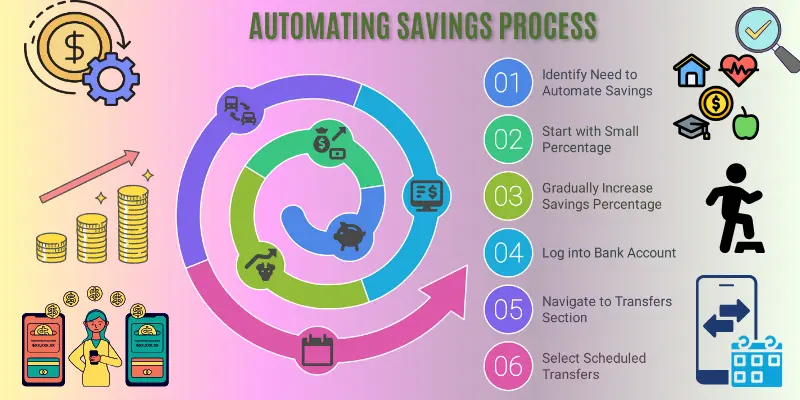
Set It and Forget It: The best way to build savings is by making it automatic. Set up a scheduled transfer from your checking account to your savings account every time you’re paid. This way, you don’t have to worry about remembering or tempting yourself to spend that money.
Actionable Tip: Start Small and Increase Over Time
- Start with 5% of your income: Even a small amount can add up over time, and starting small makes it less painful.
- Increase gradually: Once you’ve gotten used to saving a small amount, gradually increase the percentage (e.g., 5% to 10%) to reach your savings goals faster.
Example: Setting Up Automatic Transfers
Most banks and financial institutions offer an easy way to set up automatic transfers. Here’s how:
- Step 1: Log into your bank account (via online banking or mobile app).
- Step 2: Go to the “Transfers” section and select “Scheduled Transfers.”
- Step 3: Choose the amount you want to transfer, the frequency (e.g., weekly, bi-weekly), and the destination account (your savings).
- Step 4: Set a date (preferably right after payday) and confirm the transfer.
By automating your savings, you take the temptation out of the equation and build a solid financial foundation. Once you’ve set it up, you’ll see your savings grow without even thinking about it. It’s an easy, stress-free way to stay on track with your financial recovery goals..
Step 12: Look for Discounts, Coupons, and Cash-Back Offers
Saving money on everyday purchases is easier than you think, especially with all the discounts, coupons, and cash-back offers available today. Whether you’re shopping for groceries, clothes, or even gadgets, there are simple ways to save without sacrificing what you need. Here’s how you can make the most of your purchases:
- Save on Everyday Purchases: Whether you’re at the store or shopping online, there are endless opportunities to save. Apps and websites that offer discounts, coupons, and cash-back can help you cut costs on everyday items.
Actionable Tip: Use Discount and Cash-Back Apps
- Honey: This browser extension automatically finds the best promo codes for you when shopping online, helping you get the best price without searching around.
- Rakuten: This app offers cash-back rewards on purchases from thousands of stores. You can earn a percentage back on everything from clothing to electronics, just by shopping through their links.
Example: Using a Coupon or Cash-Back Website for a Typical Shopping Trip
Here’s a step-by-step guide to saving on a typical shopping trip:
- Step 1: Before you make a purchase, open the Honey app or browser extension on your computer. It will automatically search for any available promo codes for the store you’re shopping with.
- Step 2: Apply the best promo code at checkout to get instant savings.
- Step 3: If you’re shopping through Rakuten, go to their website or app and search for the store where you want to shop. Click through the link, and you’ll earn cash-back when you make a purchase.
- Step 4: For regular purchases (like groceries), use apps that track coupons and discounts. Apps like Groupon or RetailMeNot can help you find the best deals near you or online.
By actively seeking out discounts, coupons, and cash-back offers, you can save more on things you buy regularly. Small savings really do add up, and over time, those extra dollars can be put toward building your emergency fund or paying off debt. It’s a simple and effective way to stretch your budget further.
Mistakes to Avoid on Your Financial Recovery Journey
When recovering from a financial setback, watch out for these common mistakes:
- Avoiding the Problem: Ignoring the issue only makes it worse. Facing it early will make recovery easier.
- Not Having a Clear Plan: Without a clear action plan, things can quickly become overwhelming.
- Relying on Debt: Using credit to cover other debts can lead to bigger financial problems.
- Ignoring Mental Health: Financial stress affects your well-being—take care of both your money and your mind.
By avoiding these mistakes, you’ll stay on track and move forward more confidently.
“The first step to financial recovery is understanding where you stand. You can’t fix what you don’t measure.”Dave Ramsey, Financial Coach and Bestselling Author
Your Financial Comeback Starts Today: Take the First Step
Getting your finances back on track after a setback can feel overwhelming, but remember, it’s completely possible with the right steps. By following the 12 proven strategies discussed above, you’ll be on your way to financial recovery and long-term stability.
Key Takeaways:
- Assess Your Current Financial Situation: Know exactly where you stand—track income, debt, expenses, and savings.
- Create a Temporary Budget: Focus on essential expenses and cut non-essentials to stay afloat.
- Build an Emergency Fund: Start small but stay consistent to create a financial cushion.
- Communicate with Creditors: Don’t avoid tough conversations—negotiate deferred payments or lower interest rates.
- Increase Your Income: Take up side hustles or gigs to boost your cash flow.
- Stay Consistent and Track Progress: Regularly review and adjust your budget using apps or spreadsheets.
- Rebuild Your Credit: Pay bills on time, reduce credit card debt, and consider credit-building tools.
- Cut Unnecessary Subscriptions: Cancel subscriptions that no longer serve you and reduce monthly expenses.
- Seek Financial Counseling: Get professional help or use debt relief programs if needed.
- Sell Unused Items: Declutter your space and sell items for extra cash.
- Automate Savings: Set up automatic transfers to make saving easier and more consistent.
- Look for Discounts and Cash-Back Offers: Use apps and websites to save on everyday purchases.
While these steps can dramatically improve your financial situation, remember that recovery is a process. Avoid falling into the trap of relying on credit cards to cover emergencies or overspending even after you’ve made progress. Small, consistent actions are key—don’t rush or expect overnight success.
Feeling inspired to take control of your finances? Start today by applying these steps, and share your journey with others in the comments below. If you found this guide helpful, don’t forget to subscribe for more tips on financial recovery and health!
No matter where you’re starting from, every step you take brings you closer to a stronger financial future. The road to recovery might be tough, but remember, your financial well-being is worth the effort. Take the first step today and rebuild with confidence!
Got Financial Woes? Your Questions Answered
Prioritize essential expenses for your family and communicate openly about the situation. Look for ways to reduce costs and increase income.
Cut unnecessary expenses, apply for unemployment benefits, and look for part-time or freelance work. Stay proactive in your job search and consider retraining or learning new skills.
Stay calm and assess the situation. Use your emergency fund if you have one, and prioritize essential expenses. Seek assistance from community resources if necessary.
There are many free resources available online, including budgeting apps, financial blogs, and educational videos. Consider seeking advice from a financial counselor if needed.
Create a sustainable budget and stick to it. Build an emergency fund to cover unexpected expenses and continue practicing good financial habits like saving and budgeting. Regularly review your finances and adjust your plan as needed to stay on track.
Consider taking on a side gig, freelancing, or selling unused items. You can also explore opportunities for overtime at work or ask for a raise if you believe you deserve it. Temporary part-time jobs or gig work can also provide a quick income boost.

- Be Respectful
- Stay Relevant
- Stay Positive
- True Feedback
- Encourage Discussion
- Avoid Spamming
- No Fake News
- Don't Copy-Paste
- No Personal Attacks



- Be Respectful
- Stay Relevant
- Stay Positive
- True Feedback
- Encourage Discussion
- Avoid Spamming
- No Fake News
- Don't Copy-Paste
- No Personal Attacks





